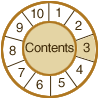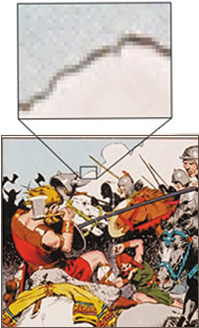
`3. Conversion
Key Conceptsintroduction
scanning factors
rich digital master
benchmarking
text
stroke
continuous-tone halftone
proposed method guidelines
additional reading

BENCHMARKING
RESOLUTION
REQUIREMENTS
BASED ON STROKE WIDTH
The QI method was designed for printed text where character height represents
the measure of detail. Manuscripts and other non-textual material representing
distinct edge-based graphics, such as maps, sketches, and engravings,
offer no equivalent fixed metric. For many such documents, a better representation
of detail would be the width of the finest line, stroke, or marking that
must be captured in the digital surrogate. To fully represent such a detail,
at least 2 pixels should cover it. For example, an original with a stroke
measuring 1/100 inch must be scanned at 200 dpi or greater to fully resolve
its finest feature. For bitonal scanning, this requirement would be higher
(say 3 pixels/feature) due to the potential for sampling errors and the
thresholding to black and white pixels. A feature can often be detected
at lower resolutions, on the order of 1 pixel/feature, but quality judgements
come into play.
 ..........
..........
Stroke: Adequately rendered cloud outline (left) and inadequately rendered border line (right).
Cornell has developed the following correlation of perceived image quality to pixel coverage:
Table:
Quality Index for Stroke Rendering
| QI | Quality Assessment |
| 2 | excellent |
| 1.5 | good |
| 1 | questionable, confirm quality onscreen |
| <1 | poor to unacceptable |
|
Grayscale/Color QI Formula for Stroke dpi = QI/.039w |
This formula correlates QI with dpi and stroke width (w) measured in mm. QI in this case is based on the quality assessment above, which correlates to the number of pixels covering the stroke (e.g., 2 = excellent). Note: if the measurement of w is expressed in inches, omit the .039.
For bitonal scanning, the formula is adjusted to compensate for feature drop out in the thresholding process:
| Bitonal
QI Formula for Stroke
dpi=1.5QI/.039w |
Many items falling into this category exhibit features beyond simple edge-based representation, and resolution will not be the sole determinant of image quality. For example, a number of institutions have recommended scanning all manuscripts in grayscale or color.
|
Reality Check What's the minimum resolution I need to scan a manuscript page in grayscale to obtain good rendering of the finest stroke, which measures .1 mm?
|
© 2000-2003 Cornell University Library/Research Department